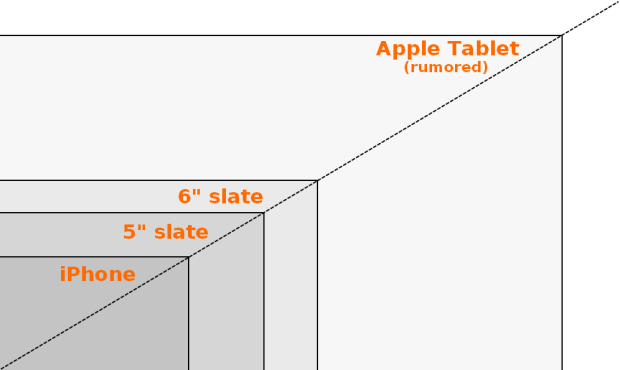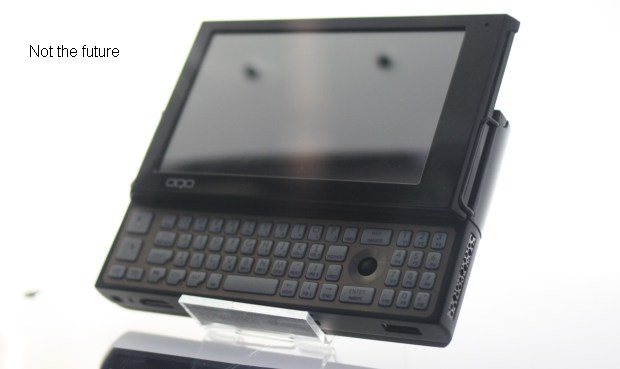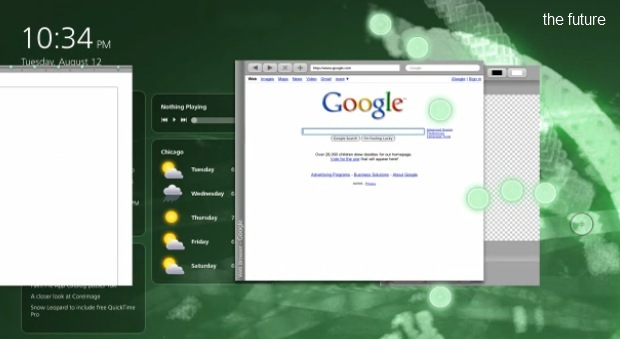
Dell debuted some sort of slate product at CES. At first I was intrigued, and then someone told me the size. Five inch screen. Five inches, people. That’s one and a half inches more than an iPhone. Take your thumbs and index fingers and make a little window with them — you know, like a photographer or director does. That’s about five inches if your hands are at all like mine. Consuming any real amount media- and text-rich content on a device that size sounds about as pleasant as eating glass.
Others, too, are bringing knives to the gun fight. Asus has a 6-inch, full-color e-book reader (why?), and HP is of course collaborating on a medium-sized, mundane tablette with Microsoft, which itself has apparently left the Courier, a genuinely innovative product, on a drawing board somewhere. Haven’t these guys heard of Archos and Viliv? There are already MIDs out there that do essentially what these allegedly next-generation devices are supposed to. The iSlate supposedly has a 10.6-inch screen. Did the competition really think half that would be enough?
Check out this handy little size chart I made. I used the scale 100px/inch along the dotted line; with my DPI, that’s about life-size when you blow it up, but you get the idea:

I’m not sure exactly what the draw is to small-screen devices like this. With phones and PMPs, the idea is that you operate them like an iPod: in your palm, with your thumb or the index finger of your other hand. Usually there is one point of contact, so UIs are designed around that. Multi-touch is in the process of becoming mainstream, so there’s a change to look for in those devices. But tablets and slates aren’t PMPs. They aren’t phones. The idea is that they are complete PCs without keyboards. I mentioned Viliv and Archos: their tiny PCs are capable, but even the best MIDs have cramped screens and input trouble. Optical track nubbins? Stylii? You’ll never break through with that kind of anti-fun going on with your device. Remember OQO? Beautiful devices, no sales.

What exactly a tablet is will be, for better or worse, defined when Apple puts theirs out. I don’t suggest that theirs will be all things to all people, but for lack of credible competition it’s going to set the bar (and set it high, if we’re lucky). Other tablet-like products out there — convertibles, Windows 7 tablets, MIDs, high-end smartphones — either shrunk the desktop OS or added some functionality to a mobile one. So you’ve got a TG02 with a nice big 4″ screen (it’s gorgeous) — is that a tablet because it’s bigger than any other smartphone? No, it runs WinMo. Similarly, is a 6″ MID running XP a tablet? No, because XP and its applications aren’t tablet-friendly; maybe 7 is more so, but it’s still a desktop OS at heart.
Imagine the difference between using a stylus to simulate a mouse-driven cursor on an OS where corners are the most accessible UI elements and pixel precision is assumed, and using your fingers to manipulate objects with natural gestures. That, after all, was the primary UI difference between the iPhone and other mobile OSes. Microsoft’s Surface team contributed a lot of touch elements to Windows 7, but it’s still designed by and large for a mouse. Compare that to the 10/GUI concept, or even Chrome OS, which seems much more susceptible to multi-touch adaptation. And I should add that even with a tailored UI, a 6-inch screen is going to require a lot of zooming in and out. I don’t enjoy doing that, and neither do you. Why would you want a device that continues this troublesome tradition?
But it’s the form factor, you say! It doesn’t matter if the OS was made for the tablet as long as you can sit on the couch and check your blogs without a keyboard. To some extent, yes — but it’s a bit like cutting your food with a spoon, isn’t it? I imagine the caveman, saying “But fire not necessary! Mammoth meat delicious raw!” To him I say: taste the grilled mammoth first, sir, and then decide.
True, content providers have adjusted their content to be accessible by mobile devices — and we all know how tiring it is to read more than a page or two of the Times on an iPhone, and how arbitrarily limited apps for certain web services are. That crippled content will still be offered for mobiles and MIDs, but true tablets/slates (of which Apple’s may be the first) will have a separate, richer stream that relies on the increases in the device’s input options, screen real estate, and computing power. As I noted above, it’s not enough to shrink or grow existing UIs or OSes: all you end up with is ten pounds of OS in a five pound bag, or vice versa.

When I say Apple will define the tablet, I mean that literally: it’s going to create definition. It’s actually much the same as with the iPhone: a stagnant device class with lots of potential, weighed down by traditional UI and input elements. Apple comes in like Alexander and cuts the Gordian Knot, defining an entirely different experience that resonates with consumers. Apple didn’t create the smartphone, but smartphones are now defined in terms of the iPhone.
The field is a little fresher with tablets, of course: it’s not as big of a market and the stagnation is largely due to technical limitations only now being overcome. And there will be real competition as well; Google-branded Chrome OS tablets are probably going to come out later this year along with laptops, which will be cheaper and less media-oriented. But at any rate, it looks like they are among very few companies offering an experience substantially different from MIDs of the past — an experience people might actually pay for.
The point is that the big guys, unless they’ve really improved their poker face recently, have started out on the wrong foot — and they’re about to take one in the jaw when Apple drops a tablet that is not only larger and sexier but far more usable than the toys Microsoft and Dell think people will want. If they can’t learn to take risks with major departures from UI and design establishments, they shouldn’t be surprised if they get left in the dust.
Matt here: Listen, Devin is right. Most 5-inch tablet computers — not strictly mobile devices — are horrible. But the small screen size is not to blame. It’s Windows. Windows is horrible on a small screen device. It was designed to be used on a 15-inch monitor with a mouse, not on a portable, touchscreen devices. Windows 7 has slightly better touchscreen controls, but it’s still not meant for small screens.
Take the Inkia MID500 I just got in for review. It’s nearly useless because of the 5-inch screen. Watch the video to see how it renders webpages. But the 9-inch screen in the Viliv X70 is nearly large enough for most Windows’ tasks. I use one everyday for TweetDeck and Slacker Radio, but I also have the tablet mounted to my desk and I use a wireless mouse to navigate Windows.
Android is great on a small screen. So is Nokia’s Maemo. Even the Linux-powered Jolicloud or the browser-based Blump.it dramatically improves the user experience on the small screen because of the simple control schemes designed to be used with a finger on a smaller screen. Apple likely knows all this and probably didn’t simply port OS X to its upcoming slate offering.